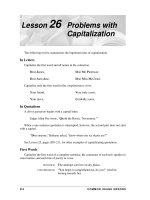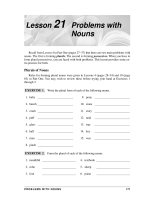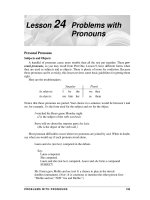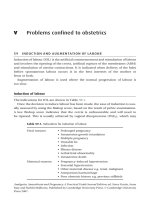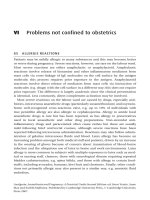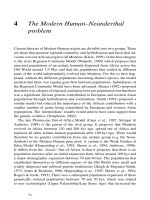Defining MR problem
Bạn đang xem bản rút gọn của tài liệu. Xem và tải ngay bản đầy đủ của tài liệu tại đây (278.33 KB, 28 trang )
Recap
What is Marketing Research?
Why do Organizations Need Market Research?
What sort of information is needed – generally?
Why and When does Marketing Research Work?
The Marketing Research Process
Step 1: Identify and define the Problem or
Opportunity
Step 2: Define the Marketing Research Problem
Step 3: Specify the Research Design
Step 4: Develop the Data Collection Procedure
Step 5: Design the Sampling Procedure
Step 6: Collect the Data
Step 7: Process and Analyze the Data
Step 8: Present the Results
Step 1: Identify the Problem or Opportunity
Management decision Problem asks what the decision
maker needs to do?
What should/can Subaru do to expand its share of the
Automobile market?
What do we need to know to identify or define the problem?
•History of the problem
•Environment in which it is being made (eg legal,
competitive, economic, financial, social)
•What alternative courses of action are there?
•What criteria should we use to decide between alternatives
(e.g. sales targets, market share, profitability, ROI)
•What is the timing of the decision?
•Who are the decision makers and what are their purposes?
Why is it important to clearly define the management
decision problem?
Because problem definition sets the course of the entire project
Because the client is paying for the research so both need to know
what to expect
Because mistakes made at this level grow into larger, more
expensive mistakes later on.
The problem definition process provides guidelines on how to
correctly define the marketing research problem
All the effort, time and money spent from this point on will be
wasted if the problem is not properly defined.
Step 2: Define the Marketing Research Problem
A statement of the information needed to make
a sound decision
What’s wrong with these statements?
1. Develop a marketing strategy for the brand.
2. Improve the competitive position of the firm
3. Improve the company’s image
What’s wrong with this statement?
1. How should the company adjust its pricing given
that a major competitor has initiated price changes?
What are the various needs of automobile users and to what
extent do current product offerings satisfy those needs?
What information is needed to answer this question?
1. What needs do buyers of passenger cars, stations wagons, and
SUV’s seek to satisfy. Hypotheses?
2. How well do existing automobile product offerings meet these
needs? Hypotheses?
3. Is there a segment of the automobile market whose needs are not
being met? Hypotheses?
4. What automobile features does this segment in question 3 desire.
Hypotheses?
5. What is the demographic and psychographics profile of the
identified segment? Hypotheses?
Research Q: Is there an overlap between the features sought
by station wagon buyers and buyers of sports utility vehicles
Hypothesis 1: The buyers of station wagons rate certain
features of SUVs as important
Hypothesis 2: The buyers of SUVs rate certain features of
station wagons as important
Component Analysis – specific information needed
make a list of the information that should be collected for each
research question and hypothesis
E.g. Component 1.
needs of buyers of passenger cars operationalized in terms of the
attributes or features desired in an automobile
Component 1. needs of buyers of SUVs operationalized in terms of
the attributes or features desired in an automobile
Component 2:
Evaluation of passenger cars on desired attributes
Evaluation of station wagons on desired attributes
Evaluation of SUVs1` on desired attributes
The Marketing Problem versus
the Marketing Research Problem
A distinction must be made between the management
problem and the marketing research problem.
Management Problem
Marketing Research
Problems
• Focus on symptoms
• Focus on causes
• Action oriented
• Data oriented
Examples of the Relationship between Decision
Problems and Research Problems
Decision Problems
Research Problems
How should we develop a package for
a new product
Evaluate effectiveness of alternative
package designs
Increase market penetration through
the opening of new stores
Evaluate prospective locations
Increase store traffic
Measure current image of the store
Increase amount of repeat purchasing
behavior
Assess current amount of repeat
purchasing behavior
What should be done to increase
market share of product
Determine the relative strengths and
weakness of the product with respect to
competitors
Allocate advertising budget
geographically
Determine current level of market
penetration in the respective areas
Introduce new product
Test likely acceptance of the new product
Assess probable market size and share.
1. Management Decision Problem
Should Bank X implement ATM surcharge fees on Consumers who are not customers of the bank but use the Bank's ATMs?
2. Marketing Research Problem
Quantify the impact of implementing the new ATM surcharges will have on the ability to attract new customers, retain existing
customers, and the impact on ATM usage of non customers.
3. & 4. Marketing Research Objectives & Hypotheses
Research Objectives
Hypotheses
Evaluate the impact of the new fees on the Bank's
image
The Bank's image will be hurt as well as the overall industries image
will suffer because it is already seen as greedy and these fees will be
another example in the public's view. The impact will be mitigated if
all banks implement the fee.
Develop a profile of the customers most impacted by
the new fee
The typical ATM user will be younger and have smaller balances.
The heaviest users will be those who keep little money with the bank
and therefore contribute the least to the bank’s profitability.
Quantify the potential gain of non-customers that
will move to the bank to avoid the fees
Some fee-sensitive customers will move to the banks with large ATM
networks while others will restrict their ATM usage. However, more
customers will change behavior rather than change banks.
Determine the expected change in customer behavior
if the fees are implemented.
The overall number of ATM transactions will decrease, especially
those at non-bank ATMs and there will be an increase in more
expensive Branch transactions
Quantify the net financial impact of implementing
the fee
A $1 fee on non-bank customers ATM transactions will outweigh the
decrease in overall ATM transactions that will be encountered and
add additional profits to the bank.
Defining the marketing/management problem
Step 3: Specify the Research Design
This step involves deciding the type of research that is
going to be used and the source of the data.
For example, deciding between exploratory,
experimental, or descriptive research
Exploratory Research
When is it used?
•When looking for insights into the problem
•To help define hypotheses and key variables
•Information needs vague
How is it characterized
•Research is flexible and unstructured
•Findings tentative
•Used as building block for more research
•e.g. pilot surveys, secondary data, focus groups
Descriptive Research
What is the Objective?
To describe something, e.g. market characteristics
What characterizes descriptive research
•Problem well understood
•Tests specific hypotheses
•Formal and structured
•e.g. surveys
•Large representative samples
•Provides a snapshot of the market environment
Causal Research
What is the objective of causal research?
To obtain information regarding cause and effect
relationships
Characteristics?
•Independent variable manipulated in a relatively controlled
environment
•Main method is experiment
•Used to understand which variables are causes (independent
variables), and which variables are the effects (dependent
variables)
Understanding
of problem?
Problem?
Poor
EXPLORATORY or
SECONDARY
RESEARCH
Good
Need to
establish
causality?
No
Yes
Objective
answers by
asking?
Yes
No
OBSERVATIONAL
RESEARCH
EXPERIMENT
Need estimates
of prevalence?
No
FOCUS GROUPS
Yes
SURVEY
Step 4: Develop the Data Collection Procedure
• Decide whether the data will be collected through surveys, interviews, focus
groups, etc.
Step 5: Design the Sampling Procedure
• Decide who will be in the sample, how those people are
selected, and the size of the sample.
Step 6: Collect the Data
• In this step, the researcher goes out and collects the
data or a research supplier collects the data.

